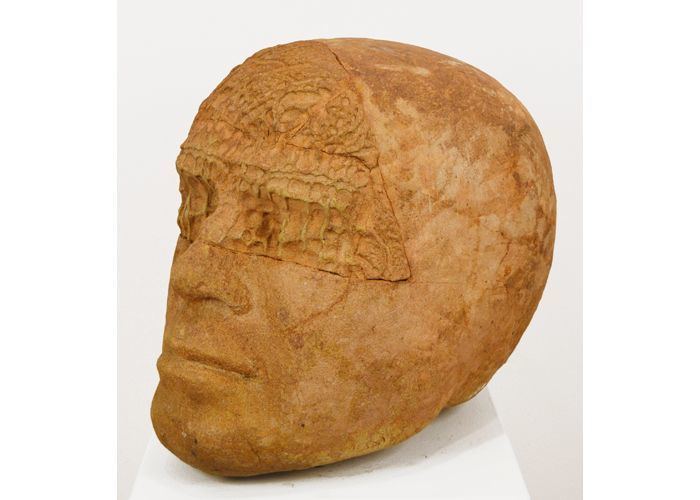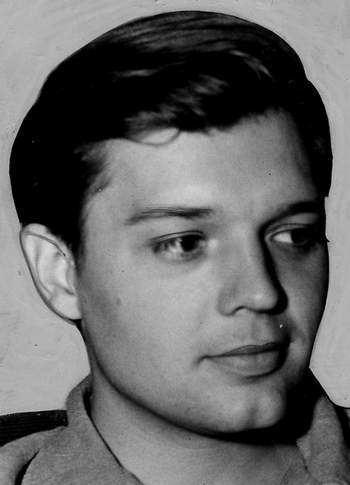Name Daniel Rhodes | Role Author | |
 | ||
Books Vampires: Emotional Predators, Revolution, Blood Double, To the Bone, LA Mental LP: A Thriller | ||
Daniel Rhodes (May 8, 1911 – July 23, 1989) was an American ceramic artist, sculptor, author and educator. During his 25 years (1947–1973) on the faculty at the New York State College of Ceramics at Alfred University, in Alfred, New York (a division of the State University of New York), he built an international reputation as a potter, sculptor and authority on studio pottery.
Contents

Background

Born and raised in Fort Dodge, Iowa, the son of Daniel J and Margaret Agnes (Brennan) Rhodes, he began his art career by enrolling in summer courses at the Art Institute of Chicago. He attended the University of Chicago for four years (1929–1933), earning a Bachelor of Arts degree with a major in art history. He worked with Iowa painter Grant Wood for two summers (1932 and 1933) at the Stone City Art Colony, and then also studied at the Art Students League of New York (1933–34), where his teacher was Regionalist painter John Steuart Curry.

From 1935 to 1938, Rhodes lived in Fort Dodge, where he worked as a painter and muralist, participated in the Fort Dodge Art Guild, and lectured at the Blanden Art Gallery (now the Blanden Memorial Art Museum. While living in Iowa, he participated actively in the state’s art circles, and frequently exhibited at the Iowa State Fair, where he won an unprecedented three consecutive annual sweepstakes awards for oil painting from 1938 to 1940, outdistancing a record held by Grant Wood.
After additional study in 1940 at the Colorado Springs Fine Arts Center (where he began to work with clay), Rhodes entered the graduate program at New York State College of Ceramics at Alfred University, where, in 1942, he became the first person to graduate from that school’s Master of Fine Arts program.
Murals
Rhodes received several mural commissions from the Section of Painting and Sculpture. The first, titled Storm Lake (1937), was created for the post office at Storm Lake, Iowa. Later, when a new post office was built, the mural was relocated to the public library.
In the same year, Rhodes and another Iowa painter named Howard C. Johnson were commissioned to create a large mural (110 feet wide by 10 feet (3.0 m) high), planned for installation in the Agricultural Building at the Iowa State Fairgrounds in Des Moines. Titled Where tillage begins, other arts follow, the project was a commemoration of Iowa agriculture: planting, harvesting, production, and the meat packing industry. Unfortunately, it soon became the subject of a public derision. Opinionated passersby complained about factual inaccuracies in the mural, claimed that the figures of Iowans were too solemn, and objected to what they considered to be a style that was “too modern.” In 1946, Iowa State Fair Board Secretary Lloyd Cunningham ordered that the mural be taken down and that the dismantled pieces be used as scrap lumber. Apparently, all that now survives of the mural are a few photographs.
Another mural, at Marion, Iowa, is titled Communication by Mail (1939). Rhodes painted this mural in the time-honored technique of fresco-secco, directly onto the Post Office's lobby wall. It features the role of the railroad in transporting mail. The Post Office was decommissioned and sold to the city of Marion in 1968. The city used the building as the City Hall until 2005. The building sat empty for a year before being bought by a bank. In June 2008, Anton Rajer a professional fine art conservator from Green Bay, WI will begin work to move the mural to the Marion Heritage Center. The mural is estimated to weigh approximately 2,000–3,000 pounds, and will be removed from the building in one piece by a team of contractors.
Rhodes created a mural, Airmail (1941), for the U.S. Post Office in Piggott, Arkansas.
His success in completing these projects led to Rhodes being commissioned for New Deal art projects in other states, including post office murals at Clayton, Missouri (now at the Federal Building in Des Moines), and Glen Ellyn, Illinois; and a cafeteria mural in the main U.S. Navy building in Washington, D.C.
Later career
In 1939-40, Rhodes taught at the Art Students’ Workshop in Des Moines, and was also a guest lecturer at the Ottumwa Art Center and Iowa State University. In 1940, he married the former Lillyan Estelle Jacobs of Des Moines, a potter, sculptor and figurative painter whom he had met at Stone City. They raised two children, a daughter (Lorna) and a son (Aaron). Lillyan Rhodes died in 1986.
After completing his MFA at Alfred University, the Rhodes remained in that area, where he worked as a designer for Glidden Pottery. In 1943, they moved to California, where he worked in San Jose as a researcher in high heat ceramics for the Henry J. Kaiser Corporation. Three years later, they moved to Menlo Park, California, where in 1947 they built a full-scale ceramic studio, and created thrown and cast ware for Gump’s, the San Francisco department store. During the same period, Rhodes was briefly on the faculties at Stanford University (1946) and the San Francisco Art Institute (1946–47). In 1947, they returned to New York State, where Rhodes joined the art department faculty of his alma mater, the New York State College of Ceramics at Alfred University, where he taught from 1947 to 1973.
While at Alfred University, Rhodes also taught summer sessions in ceramics at the University of Southern California, Los Angeles (1952–53); Black Mountain College, Asheville, North Carolina; and the Haystack Mountain School of Crafts, Deer Isle, Maine (1961). Rhodes later taught at the University of California, Santa Cruz (1977–80).
In the last phase of his life, Rhodes married Mary Beth Coulter. At the start of a two-month tour of college campuses, he was conducting a workshop at Sierra Nevada College when he was stricken by a heart attack and died in Reno, Nevada, in July 1989, aged 78.
Awards, honors and collections
Rhodes was the recipient of a Fulbright Fellowship and lived in Japan from 1962-63. The National Council on Education for the Ceramic Arts (NCECA) awarded him a medal of citation for his contributions to teaching in 1973. His accomplishments were recognized by major retrospectives at the Blanden Memorial Art Museum, Fort Dodge, Iowa (1973), and at Iowa State University, Ames (1986).
Rhodes' work is in permanent collections at the Victoria and Albert Museum (London); National Museum of Modern Art, Kyoto (Japan); Smithsonian Institution (Washington DC); Museum of Contemporary Crafts (New York); Des Moines Art Center (Des Moines, Iowa); Blanden Memorial Art Museum (Fort Dodge, Iowa); and Cornell University (Ithaca, New York).
In June 2011, a Facebook page, "Daniel Rhodes Centennial", was established to commemorate the 100th anniversary of his birth.
Writings
As an authority on ceramics techniques, Rhodes is well known as an author among studio potters and ceramic sculptors.
